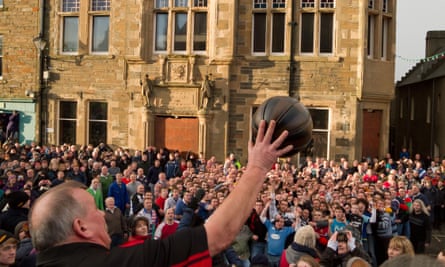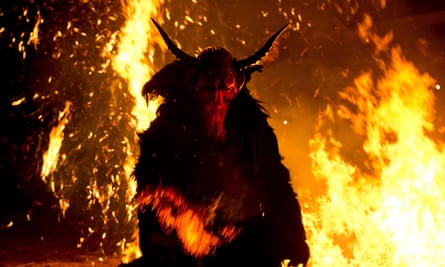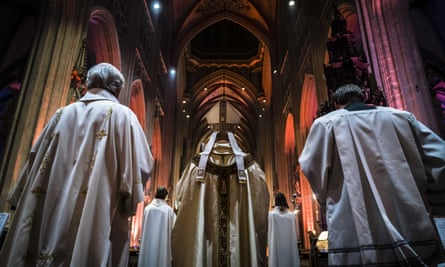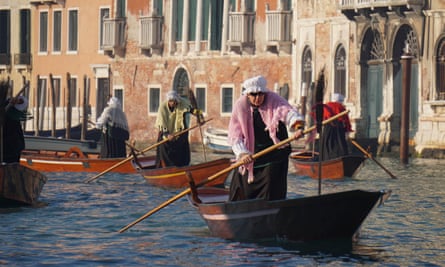
Trolled by Iceland’s Yule Lads
According to legend, the Yule Lads are the sons of a troll named Grýla and come down one by one from the mountains to cause trouble but also to leave gifts in the shoes of children. The first to arrive, on 11 December, is Stekkjastaur, who bothers the sheep (he tries to drink milk straight from the ewe’s teat) in Icelanders’ farms. The next day Giljagaur arrives: he is known for stealing the froth from cow’s milk. On the 13th, it’s Stúfur, who steals food from frying pans. Then there’s Þvörusleikir (spoon-licker), Pottaskefill (pot-scraper), Askasleikir (bowl-licker), Hurðaskellir (door-slammer), Skyrgámur (skyr yoghurt-gobbler), Bjúgnakrækir (steals sausages), Gluggagægir (window-peeker), Gáttaþefur (door-sniffer), Ketkrókur (meat hook) and Kertasníki (candle-beggar). And then, in the same order in which they came, when the last Yule Lad has departed, Christmas is over.
Collette
Orkney celebrates festivities with the Ba game in the main town of Kirkwall: a scrum of 200-plus people on two opposing teams – the Uppies and the Doonies – competing to get a ball to a destination on either side of town. The shops and houses along the streets get out planks of wood to protect their facades, and a blanket of steam rises above the crowd as the game gets serious. One of the better-known legends surrounding the origins of Ba suggest it was first played with the severed head of a mainland tyrant called Tusker. Another tradition islanders indulge in is first-footing, still a well-kept Hogmanay tradition in various parts of Scotland, where you hop between the houses of strangers and friends through the night, with a bottle to toast the new year.
Cassia Dodman
Tableaux and toilet humour, north-east Spain
In Catalonia some small towns put beautifully lit crib tableaux, enacting scenes from the nativity story, in windows and open spaces. Often an ancient market is depicted, always with a donkey and some sheep. And the infamous caganer is often to be found among the angels and villagers (a nativity scene figurine in the act of defecation). It is magical walking slowly round, often with seasonal music, hardly recognising familiar lanes and finishing the evening with a glass of local wine and a sweet biscuit.
Libby Harris
Viennese twist, Austria

Last year, while strolling around the elegant streets of Vienna, my kids were treated to the shocking spectacle of half-demons, half-goat creatures emerging from bars, cafes and houses. Apparently in mid-December Krampusnacht is celebrated, a throwback to the darkest Grimm fairytales. The Krampus is a devil-like creature with matted fur, stag horns and flaming coals for eyes, unleashed to punish naughty children. He often has a huge birch branch in his hand ready for beating people. After, that, my two teenagers were grateful for even the most simple present at home!
Yasmin
Into the woods, Serbia
In Serbia, the village men traditionally wake up before dawn on Christmas Eve (6 January in Serbia) and head into the woods to cut oak branches (badnjak) taking homemade šljivovica (plum brandy) and bread to help them keep warm in the freezing weather. As darkness falls the branches are carried home to use on the fire. As the men enter with the wood, women shower them with nuts, dried fruits, wheat and coins. Only then has Christmas arrived and a the advent fast is broken with a midnight meal.
Nilo
Pop into the cathedral, the Netherlands

Many people in the Netherlands visit the nativity scene in the St John’s Cathedral in ’s-Hertogenbosch (Den Bosch) at Christmas. The scene is set in the 13th century, at the time when St John’s was being built. Those who pass through the portal are promised everlasting happiness. On the way over you have to listen to the Top 2000 on Dutch station NPO Radio 2: the programme starts at midnight on 25 December and ends at midnight on 31 December. It plays the 2,000 pop songs voted best of all time. First broadcast in 2000, it has proved a hit with listeners young and old. Number one is usually Queen’s Bohemian Rhapsody, although The Eagles, John Lennon, and Dutch stars Danny Vera and Boudewijn de Groot have made it to top spot too.
Monique Gadella
Profile
Readers’ tips: send a tip for a chance to win a £200 voucher for a Sawday’s stay
Show
Guardian Travel readers’ tips
Every week we ask our readers for recommendations from their travels. A selection of tips will be featured online and may appear in print. To enter the latest competition visit the readers’ tips homepage
–
Hide your brooms, Norway
One Norwegian Christmas Eve tradition is for people to hide their brooms. This is based on the belief that that witches venture out on Christmas Eve looking for broomsticks to ride on. Yes, what a lot of twaddle. I told them “witch posts”, in the form of a saltire hex sign on a fireplace, are far more effective for keeping witches at bay – it is well known, in northern England at least, that witches enter houses via the chimney.
Mark Rounding
Well-meaning witch, Italy

In Italy young children look forward to a visit over Christmas from La Befana. She is an ageing, well-meaning witch in black cape and black hat, who flies around among the stars over the 12 days of Christmas before landing on the Epiphany – 6 January. One story is that La Befana led the three kings, who got lost following the star on their trip to Bethlehem. She concludes the Italian festive season with simple gifts for children such as sweets – or lumps of coal for naughty ones. I found this a charming tradition when I lived in Italy.
Nigel Cox
Winning tip: A fish called Albert, Czech Republic
The most bizarre Christmas tradition I’ve ever came across was in the Czech Republic. People there buy live carp and put them in their bathtub, where they swim for a few days before it becomes a Christmas dinner. Children name the fish while it’s happily bobbing about in the bath. A friend there had a fish he called Albert, which weighed around 4kg. It made a big dinner.
Radka



